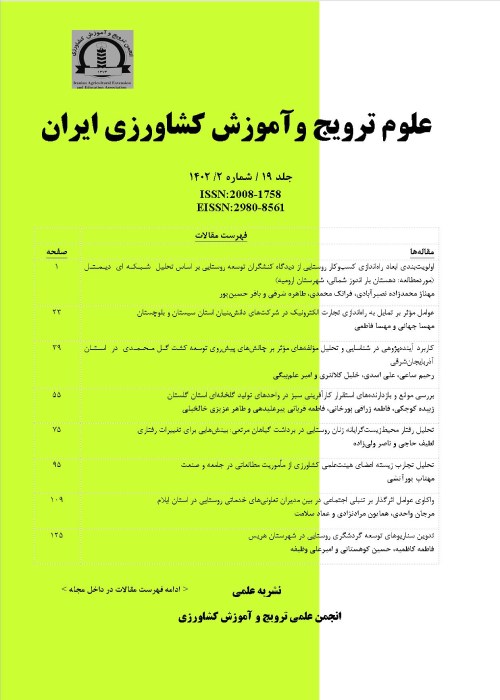The Path Analysis of Water Conservation Behavior in Agricultural Sector and Revivification of Lake Urmia: The Case of Farmers in Southern Basin of Lake Urmia
Author(s):
Article Type:
Research/Original Article (دارای رتبه معتبر)
Abstract:
Discourses on the rescue of Lake Urmia from drought insist on transferring water from other areas which may cause the transition of crisis to those areas. Modifying of the pattern of water use in the related sectors with this ecosystem has been less considered. Nevertheless, optimal use of water in agriculture is an effective way to save water resources as well as returning the surplus water to redistribute into the Lake. Factors affecting the behavior of farmers with the emphasis on the environmental non-governmental organizations` (NGOs) role was the main objective of the study. The theoretical framework of the study was developed based on the Theory of Goad-Directed Behavior (TGB) adopted from Perugini and Conner. All of the farmers in Southern basin of Lake Urmia, Miandoab city (N: 23750) were the research population in which a sample of 368 farmers was selected based on Krejcie and Morgan`s Table using stratified random sampling method. The survey was accomplished by a questionnaire. The faculties of Agricultural Extension and Education evaluated the face validity of the questionnaire and the consistency of the items of the research indices was confirmed through Confirmatory Factor Analysis (CFA) using AMOS, version 20. The descriptive and inferential statistics were analyzed by SPSS. According to the results of path analysis (PA), the perceived behavioral control and environmental NGOs performance had direct effect on water-saving behavior, and desire to collaborate in environmental NGOs and desire to revive the Urmia Lake had indirect effect on water-saving behavior by mediation of the intention to collaborate in environmental NGOs and the water-saving intention. At last, some recommendations were presented in order to improve the farmers` behavior regarding water use as well as their participation increase in environmental NGOs.
Keywords:
Behavior , Water Use , NGOs , Agriculture , Urmia Lake
Language:
Persian
Published:
Iranian Agricultural Extension and Education Journal, Volume:13 Issue: 2, 2018
Pages:
251 to 268
magiran.com/p1805327
دانلود و مطالعه متن این مقاله با یکی از روشهای زیر امکان پذیر است:
اشتراک شخصی
با عضویت و پرداخت آنلاین حق اشتراک یکساله به مبلغ 1,390,000ريال میتوانید 70 عنوان مطلب دانلود کنید!
اشتراک سازمانی
به کتابخانه دانشگاه یا محل کار خود پیشنهاد کنید تا اشتراک سازمانی این پایگاه را برای دسترسی نامحدود همه کاربران به متن مطالب تهیه نمایند!
توجه!
- حق عضویت دریافتی صرف حمایت از نشریات عضو و نگهداری، تکمیل و توسعه مگیران میشود.
- پرداخت حق اشتراک و دانلود مقالات اجازه بازنشر آن در سایر رسانههای چاپی و دیجیتال را به کاربر نمیدهد.
دسترسی سراسری کاربران دانشگاه پیام نور!
اعضای هیئت علمی و دانشجویان دانشگاه پیام نور در سراسر کشور، در صورت ثبت نام با ایمیل دانشگاهی، تا پایان فروردین ماه 1403 به مقالات سایت دسترسی خواهند داشت!
In order to view content subscription is required
Personal subscription
Subscribe magiran.com for 70 € euros via PayPal and download 70 articles during a year.
Organization subscription
Please contact us to subscribe your university or library for unlimited access!


